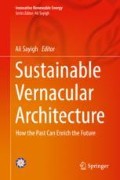Abstract
This study examines the impact of building use variable on the energy retrofit for vernacular buildings. In Italy, the main part of the building stock is composed of urban textures based on vernacular buildings. This part shares regional values and features that distinguish the landscape and influence the global primary energy demand of buildings sector. Moreover, historical towns underwent a renovation process which includes changes of use driven by economic factors and totally unaware of the effect on energy performance. The result of the study shows that the criterion of appropriate building use transformation could lead to a consistent reduction in energy demand for heating and cooling. A case study of the Casa Medori in Civita di Bagnoregio (Italy) demonstrates that this reduction is about 20%. Based on the findings, it can, therefore, be stated that to determine the suitable building use in relation to energy performance is crucial to limit others retrofit strategies that affect building elements and appearance. Besides, this criterion complies with conservation principles for cultural heritage and retains the significance of the building.
Access this chapter
Tax calculation will be finalised at checkout
Purchases are for personal use only
References
Baker N, Steemers K (2000) Energy and environment in architecture: a technical design guide. E & FN Spon, London, New York
Bascia L, Carlotti P, Maffei GL (2000) La casa romana nella storia della citta dalle origini all’Ottocento. Alinea, Firenze
Ben H, Steemers K (2014) Energy retrofit and occupant behaviour in protected housing: a case study of the Brunswick Centre in London. Energy Build 80:120–130. https://doi.org/10.1016/j.enbuild.2014.05.019
Carbonara G (2015) Energy efficiency as a protection tool. Energy Build 95:9–12
Egusquiza A, Brostrom T, Pagliula S, Hermann C, Rodwell D (2016) Strategic assessment of historic cities for energy efficiency retrofits to enable their long-term use and conservation development of the EFFESUS methodology and software tool. In: Bogusław S (curatore) Herit. Futur. Herit. Transform. Cult. Herit. Prot. XXI Century – Probl. Challenges, Predict. ICOMOS, Lublin, pp 60–81
European Climate Foundation (2010) Roadmap 2050: a practical guide to a prosperous, low carbon Europe
Gargano M (1988) Civita di Bagnoregio. In: Lattanzi F, Polci S (curatori) L’ambiente, la memoria, Progett. Testimonianze su Civita di Bagnoregio. Sugarco Edizioni, Milano, pp 29–50
Garnier J-P (2016) Architettura e Anarchia, un binomio impossibile. Nautilus autoproduzioni, Torino
Geva A (2015) Energy Simulation of Historic Buildings: St. Louis Catholic Church, Castroville, Texas. APT Bull 29:36–41
Guidoni E (1980) L’architettura popolare italiana. Laterza, Bari
Gynther L, Lappillone B, Pollier K (2015) Energy efficiency trends and policies in the household and tertiary sectors. An analysis based on the ODYSSEE and MURE databases. p 97
Habraken NJ (2000) The structure of the ordinary: form and control in the built environment. MIT Press, Boston
Illich I (1984) Il genere e il sesso. Mondadori, Milano
ISTAT (2017) Database ISTAT 2017. http://dati.istat.it/. consultato 24 agosto 2017
Ole Fanger P, Toftum J (2002) Extension of the PMV model to non-air-conditioned buildings in warm climates. Energy Build 34:533–536. https://doi.org/10.1016/S0378-7788(02)00003-8
Soda pro s.d. http://www.soda-pro.com/web-services/typical-years/normal-year-global-radiation-temperature. consultato 10 marzo 2018
Strachan P, Svehla K, Kersken M, Heusler I (2016) Reliable building energy performance characterisation based on full scale dynamic measurements. In: IEA (curatore) Rep. Subtask 4a Empir. Valid. common Build. energy Simul. Model. based situ Dyn. data. KU, Leuven
Strappa G, Carlotti P, Camiz A (2016) Morfologia urbana e tessuti storici: il progetto contemporaneo dei centri minori del Lazio. Gangemi Editore, Roma
Taut B (1991) Una casa d’abitazione. Franco Angeli, Milano
Vieites E, Vassileva I, Arias JE (2015) European initiatives towards improving the energy efficiency in existing and historic buildings. Energy Proc 75:1679–1685. https://doi.org/10.1016/j.egypro.2015.07.418
Webb AL (2017) Energy retrofits in historic and traditional buildings: a review of problems and methods. Renew Sustain Energy Rev 77:748–759. https://doi.org/10.1016/j.rser.2017.01.145
Acknowledgements
This work was developed under Sapienza University grant AR21715C82226BCC. The authors would like to thank Giovanni Attili for sharing documents and drawings of Civita di Bagnoregio and Casa Medori.
Author information
Authors and Affiliations
Corresponding author
Editor information
Editors and Affiliations
Rights and permissions
Copyright information
© 2019 Springer Nature Switzerland AG
About this chapter
Cite this chapter
Morganti, M., Habib, E., Currà, E., Cecere, C. (2019). Traditional Buildings Back to the Future. Adaptive Energy Efficiency in Reuse. In: Sayigh, A. (eds) Sustainable Vernacular Architecture. Innovative Renewable Energy. Springer, Cham. https://doi.org/10.1007/978-3-030-06185-2_18
Download citation
DOI: https://doi.org/10.1007/978-3-030-06185-2_18
Published:
Publisher Name: Springer, Cham
Print ISBN: 978-3-030-06184-5
Online ISBN: 978-3-030-06185-2
eBook Packages: EnergyEnergy (R0)

